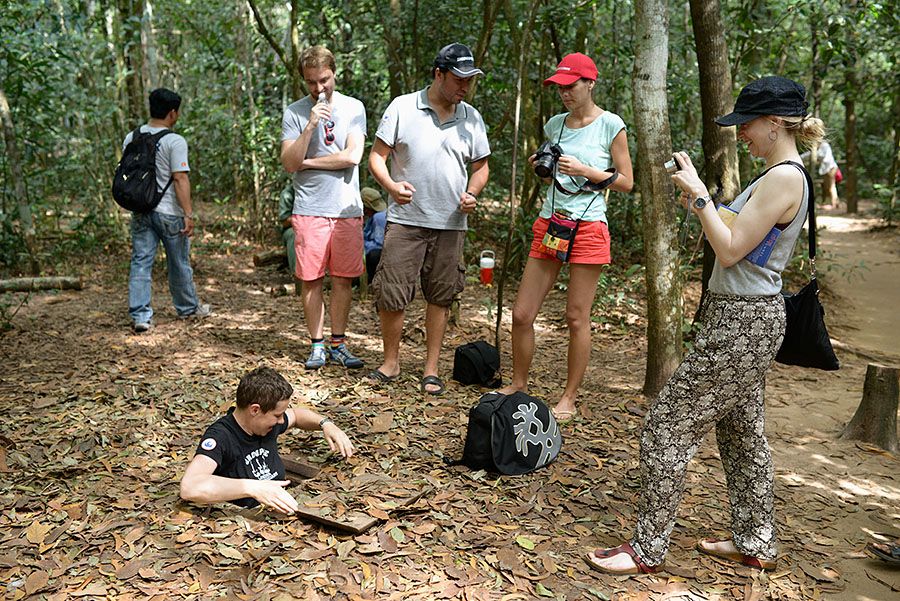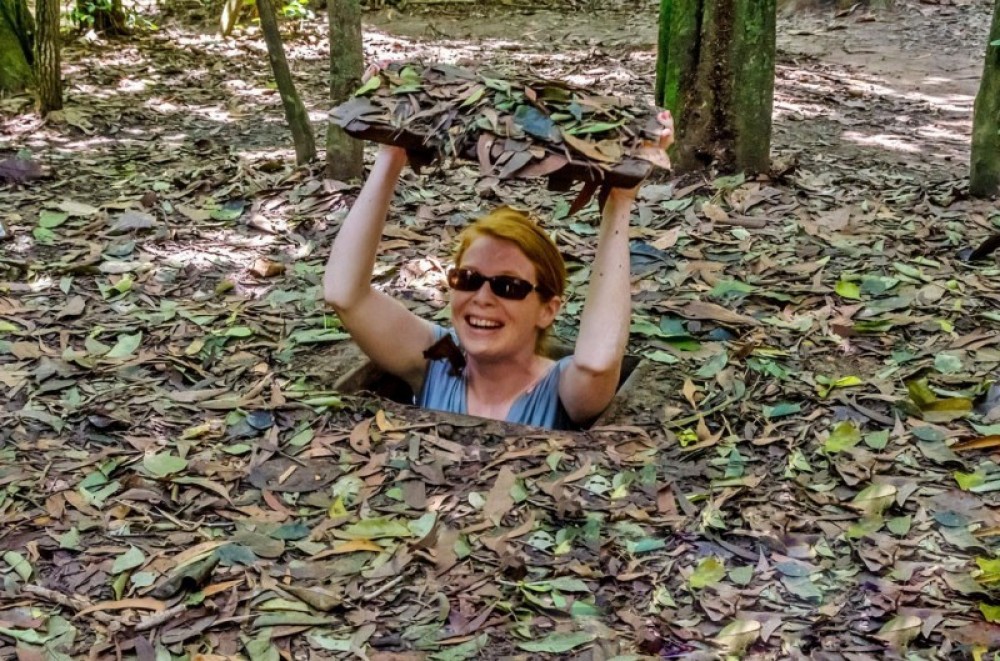Table of Contents
Nestled deep within the verdant landscapes of Cu Chi tunnels Ho Chi minh city, a district located just northwest of Ho Chi Minh City, lies a subterranean labyrinth that played a pivotal role in shaping the course of the Vietnam War: the Cu Chi Tunnels. This intricate network of underground passages, stretching over 200 kilometers, served as a sanctuary, a battlefield, and a symbol of Vietnamese resilience and determination. The tunnels bear witness to the ingenuity, tenacity, and unwavering spirit of the Vietnamese people during a turbulent period in their history.
Location and Access to Cu Chi Tunnels

The Cu Chi tunnels Ho Chi minh city are situated approximately 70 kilometers northwest of Ho Chi Minh City, easily accessible by road. Visitors can take a guided tour to explore a section of the tunnels, which have been preserved and transformed into a historical site. The entrance to the tunnels is inconspicuous, often concealed by lush vegetation, making it challenging for outsiders to locate. This strategic placement served as a defensive advantage, enabling the Vietnamese to remain hidden and undetected during the war.
How to Get to Cu Chi Tunnels
There are several ways to get to Cu Chi Tunnels from Ho Chi Minh City:
- By Bus: The most affordable option is to take a bus from Ho Chi Minh City’s central bus station to Cu Chi. The journey takes approximately 2 hours and costs around 30,000 VND (approximately $1.30 USD).
- By Taxi: Taxis are readily available in Ho Chi Minh City and can take you directly to the Cu Chi Tunnels. However, this option can be more expensive, with prices ranging from 500,000 VND to 700,000 VND (approximately $22 to $30 USD).
- By Tour: Many tour companies offer guided tours to Cu Chi Tunnels, which often include transportation from Ho Chi Minh City. This option is convenient and provides a more in-depth understanding of the tunnels’ history.
Construction and Design of Cu Chi Tunnels

The construction of the Cu Chi Tunnels began in the early 1940s as a network of simple underground shelters and storage facilities. However, during the Vietnam War, the tunnels were expanded and transformed into an extensive and sophisticated subterranean complex. The tunnels were dug by hand using rudimentary tools such as shovels, hoes, and bamboo baskets. The soil was then carried away in sacks and disposed of in nearby fields or rivers to avoid detection.
Design and Layout of Cu Chi tunnels Ho Chi minh city
The Cu Chi Tunnels were designed with multiple levels, ranging from 3 to 10 meters deep, to provide protection against aerial bombings. The tunnels were also strategically built to connect to important locations such as villages, military bases, and supply routes. The entrances to the tunnels were concealed with trapdoors, camouflaged with leaves and branches, or hidden in plain sight under kitchen floors or inside wells.
Levels of Cu Chi Tunnels
- Upper Level: The upper level of the tunnels was used for living quarters, storage, and cooking areas. It was also equipped with booby traps and escape routes in case of enemy attacks.
- Middle Level: The middle level served as a communication and meeting area for soldiers. It was also used for storing weapons and ammunition.
- Lower Level: The lower level was the most crucial part of the tunnels, serving as a base for military operations. It housed hospitals, command centers, and weapon factories.
Life Inside the Cu Chi Tunnels

Life inside the Cu Chi Tunnels was challenging and dangerous, with soldiers facing constant threats of disease, flooding, and enemy attacks. The tunnels were dark, cramped, and infested with insects and vermin. Soldiers had to adapt to living in these conditions for extended periods, sometimes up to several months at a time.
Daily Routine in the Cu Chi Tunnels
The daily routine of soldiers living in the Cu Chi Tunnels was highly regimented and focused on survival. A typical day would start before sunrise, with soldiers performing morning exercises and checking weapons and equipment. They would then spend the day on guard duty, patrolling the tunnels, or working on various tasks such as cooking, repairing weapons, or making booby traps. At night, soldiers would take turns sleeping in shifts to ensure constant surveillance of the tunnels.
Food and Supplies in the Cu Chi Tunnels
Food and supplies were scarce inside the tunnels, and soldiers had to rely on what they could grow or scavenge from the surrounding areas. They mainly subsisted on rice, cassava, and vegetables, supplemented by occasional meat from captured animals or stolen from enemy bases. Supplies such as medicine, ammunition, and clothing were also limited, and soldiers had to be resourceful in making do with what they had.
Role of Cu Chi Tunnels in the Vietnam War

The Cu Chi Tunnels played a crucial role in the Vietnam War, serving as a base for the Viet Cong (VC) guerrilla fighters and a strategic stronghold against the American and South Vietnamese forces. The tunnels provided shelter, communication, and supply routes for the VC, allowing them to launch surprise attacks and evade capture.
Military Strategies and Tactics Used in the Cu Chi Tunnels
The VC used various military strategies and tactics to defend the Cu Chi Tunnels and inflict damage on their enemies. These included:
- Booby Traps: The tunnels were rigged with numerous booby traps, including spiked pits, tripwires, and hidden explosives, to deter enemy soldiers from entering.
- Tunnel Ambushes: The VC would often launch surprise attacks on enemy troops by emerging from hidden tunnel entrances and quickly retreating back into the tunnels.
- Supply Routes: The tunnels were used to transport supplies and weapons to different parts of the country, allowing the VC to sustain their operations and maintain communication with other units.
Tourism at Cu Chi Tunnels

After the Vietnam War ended in 1975, the Cu Chi Tunnels were opened to the public as a tourist attraction. Today, it is one of the most popular destinations in Ho Chi Minh City, attracting thousands of visitors each year. Tourists can explore a section of the tunnels, learn about their history, and experience what life was like for soldiers during the war.
Attractions and Activities at Cu Chi Tunnels
- Tunnels Tour: Visitors can take a guided tour of the tunnels, which includes crawling through a section of the tunnels, viewing displays of weapons and traps, and watching a short film about the tunnels’ history.
- Firing Range: For an additional fee, tourists can also try their hand at shooting various weapons used during the Vietnam War, such as AK-47s and M16s.
- War Remnants Museum: Located near the entrance to the tunnels, the War Remnants Museum showcases artifacts, photographs, and documents related to the Vietnam War, providing a deeper understanding of the conflict.
Impact of Cu Chi Tunnels on Ho Chi Minh City

The Cu Chi Tunnels have had a significant impact on Ho Chi Minh City, both during and after the Vietnam War. The tunnels played a crucial role in the city’s defense against American and South Vietnamese forces, and their legacy continues to shape the city’s identity today.
Economic Impact
The tourism industry surrounding the Cu Chi Tunnels has brought economic benefits to Ho Chi Minh City, providing employment opportunities and generating revenue for local businesses. The tunnels have also become a source of pride for the Vietnamese people, attracting both domestic and international visitors.
Cultural Impact
The Cu Chi Tunnels have become an important cultural symbol in Vietnam, representing the country’s resilience and determination during a tumultuous period in its history. The tunnels have also been recognized as a UNESCO World Heritage Site, further cementing their significance in Vietnamese culture.
Preservation and Restoration of Cu Chi Tunnels

In recent years, there have been efforts to preserve and restore the Cu Chi Tunnels to ensure their historical significance is not lost. The tunnels have faced challenges such as erosion, flooding, and damage from tourism, but measures have been taken to protect and maintain them for future generations.
Preservation Efforts
- Reinforcement: The tunnels have been reinforced with concrete and steel to prevent collapse and preserve their structural integrity.
- Drainage Systems: Drainage systems have been installed to prevent flooding inside the tunnels, which can cause damage and pose safety hazards.
- Education Programs: Educational programs have been implemented to educate tourists about the importance of preserving the tunnels and respecting their historical significance.
Controversies Surrounding Cu Chi Tunnels
Despite its historical significance, the Cu Chi Tunnels have been a subject of controversy, with some critics arguing that they glorify war and violence. Others have raised concerns about the exploitation of the tunnels for tourism and the lack of acknowledgement of the suffering and loss of life on both sides of the conflict.
Criticisms of Tourism at Cu Chi Tunnels
- Insensitivity: Some critics argue that the commercialization of the tunnels for tourism is insensitive to the suffering and trauma experienced by soldiers and civilians during the war.
- Lack of Perspective: Critics also point out that the tunnels only showcase one side of the conflict, without acknowledging the experiences and perspectives of the American and South Vietnamese soldiers.
- Disrespectful Behavior: There have been reports of disrespectful behavior by tourists, such as taking inappropriate photos or leaving litter inside the tunnels, which can be seen as disrespectful to the site’s historical significance.
Future of Cu Chi Tunnels
The future of the Cu Chi Tunnels remains uncertain, with ongoing debates about how best to preserve and present their history. However, efforts are being made to ensure that the tunnels continue to serve as a testament to the resilience and determination of the Vietnamese people during the Vietnam War.
Plans for Development
- Expansion: There are plans to expand the tourism infrastructure at Cu Chi Tunnels, including the construction of a new visitor center and the addition of more attractions and activities.
- Education Programs: Educational programs will continue to be implemented to educate visitors about the historical significance of the tunnels and promote responsible tourism.
- Preservation Efforts: Measures will continue to be taken to preserve and protect the tunnels from damage caused by erosion, flooding, and tourism.
Conclusion
The Cu Chi tunnels Ho Chi minh city are not just a historical site but a living testament to the resilience and determination of the Vietnamese people. They serve as a reminder of the hardships and sacrifices endured during the Vietnam War and the unwavering spirit of those who fought for their country’s independence. As we continue to learn from the past, it is crucial to preserve and honor sites like the Cu Chi Tunnels, ensuring that their legacy lives on for future generations.